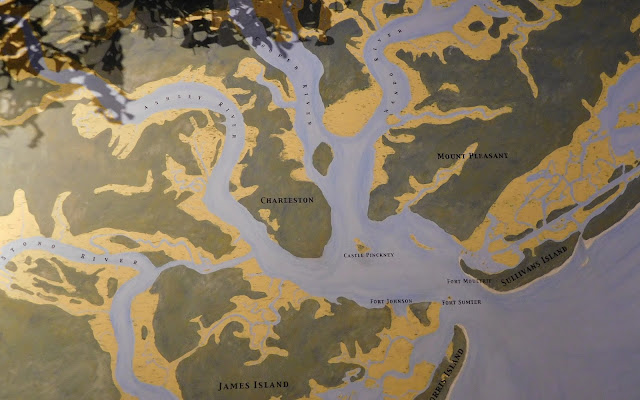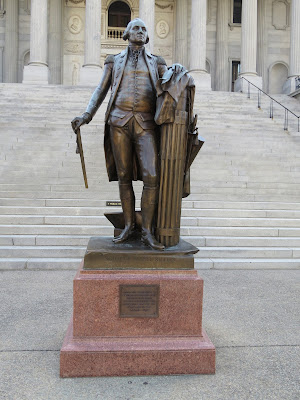“Charleston
is one of the best built, handsomest and most agreeable cities that I have ever
seen.” Marquis de Layfayette
Carol
writes: The
words of the Marquis de Layfayette, a French military officer who fought in the
Revolutionary War alongside George Washington, are just as true today as when
he spoke them back in the early days of our republic.
What all visitors to Charleston soon discover is
that… well, there’s just something about Charleston that agrees with the
soul. Charleston’s allure is not a very
well-kept secret and that is why Charleston is a chosen destination for many seeking
irresistible southern charm,
a healthy dose of our nation’s history,
a great beach destination,
or some family time with loved ones.
In Charleston, we found all four of these
‘desirables’ in abundance.
The roots of our nation’s history
are deep in Charleston, and a lot of that has to do with its geographic
setting. The city of Charleston lies on
a peninsula of land where the confluence of the Ashley and Cooper rivers flows
into the Atlantic Ocean. Charleston is
blessed by a large natural harbor with a narrow entrance bordered on one side
by a sandy beach on the tip of Sullivan’s Island. It was no secret that Charleston was a
tempting prize for the British during the Revolutionary War. On Sullivan’s Island, southern patriots responded
by building Fort Moultrie out of soft palmetto logs to protect Charleston
harbor from British warships.
South Carolina became known as “the
palmetto state.” The state flag that was
adopted in 1861 had a blue indigo background to represent the color of the military
uniforms during the Revolutionary war.
The white crescent symbol represented a gorget, a neck adornment on the
military uniform of that era. The
palmetto tree was a nod to South Carolina’s iconic sabal palm.
Our visit to Fort Moultrie coincided with the
75th anniversary of Pearl Harbor.
Somehow it seemed ironic to commemorate this solemn anniversary at a fort
that has been a part of U.S. coastal defense for 171 years.
The first American slaves arrived in Jamestown in 1619.
It is an inescapable part of South Carolina history that in the South slavery
became entrenched and vital to the southern economy. Sullivan’s Island was the port of entry for
the majority of the enslaved Africans that were shipped to North America.
Rice, otherwise known as “white gold” which was expertly cultivated by African slaves, became
the basis for South Carolina’s wealth. When
South Carolina seceded from the Union in December 1860, an inevitable march
toward Civil War was set in motion. Six
days later, two U.S. artillery companies under Major Robert Anderson evacuated
Fort Moultrie for the better fortified multi-tiered structure of Fort Sumter, a
mile away in the middle of Charleston harbor.
In the predawn hours of April 12, 1861, the first
shots of the Civil War were fired on Fort Sumter, and a national nightmare slowly
ensued… Ghastly battles over the next four years would strain the fabric of the
Union.
Within days, Major Anderson surrendered and Fort
Sumter and Charleston fell into Confederate hands and remained that way for
most of the war. I nearly had shivers
when our guide led us to the iconic view of Fort Sumter across a cannon barrel
at Fort Moultrie.
We had been anticipating our stay in Charleston for
quite some time, as we had plans to meet up with our daughter for a belated
Thanksgiving celebration. We had a
wonderful time together sharing the Charleston streets and sights …
… the carriage ride through graceful downtown
Charleston neighborhoods,
… the walk through the Battery, a fine promenade along a seawall so notable that any
picture taken there says “Charleston” like no other,
… and a ferry ride in the harbor out to Fort
Sumter (a bucket-list item for me) for a look at what has been preserved at the fort,
with its massive weaponry,
and observance of evening colors, the flag-lowering
ceremony at sunset.
Among the touristy venues in Charleston, many
local plantations sound almost a siren call to visitors. The three of us decided to check out one of
the oldest plantations in Lowcountry: Magnolia
Plantation. We found the tour mildly
interesting in that it was representative of how the house had evolved after
the Civil War. Our disappointment was
that most of the prewar home was burned by General Sherman’s Union troops as a
part of Sherman’s scorched earth tactics designed to bring the Confederacy to its
knees.
 |
| Gen. Winfield Scott's planned blockade of Confederate supply routes |
When thinking about the Civil War, massive
land battles resulting in unspeakable loss of life are usually the first images
that come to mind. A lesser talked about
aspect of that war are the battles fought by ships at sea, and these battles
were all because the Union blockade was strangling the South’s lucrative export
cotton trade.
One of the most fascinating Civil War sea stories
is one about the H.L. Hunley, a
privately funded submarine in service to the Confederate States of America. Under cover of darkness, this primitive
submarine became the world’s first successful attack submarine when she snuck
into Charleston’s outer harbor and sunk the Union blockade enforcer USS Housatonic. Unfortunately, for unknown reasons, the Hunley did not return to shore and
ultimately sank with all 8 hands aboard.
The whereabouts of the Hunley remained
a mystery for 137 years until a dive team, led by none other than novelist
Clive Cussler, located her watery grave.
To great local fanfare, the sub was raised intact
and ultimately wound up at a restoration facility run by Clemson University. Needless to say, when we found out that we
could visit the Hunley on Saturdays
at the Clemson restoration facility, Al’s bucket list suddenly had a new
addition.
Today, the H.L. Hunley sits in a tank of alkaline water. The sub was much bigger than we thought it
would be; however, conditions were very cramped for a crew of eight, seven of
which propelled the sub manually with a hand crank.
 |
| Forensic reconstruction of H.L. Hunley's crew of 8 |
 |
| Al at a hand crank station inside a replica of the Hunley |
Depth was controlled by means of manual pumps
which operated ballast tanks of sea water.
 |
| George E. Dixon Commanding officer of the H.L. Hunley |
One of the most extraordinary artifacts found
on the Hunley verified the existence of a legendary gold coin that was said
to be in the possession of the Hunley’s
captain, George Dixon. The legend was that
this coin had saved Dixon’s life by partially blocking a bullet that entered
his leg at the battle of Shiloh, and he always carried this coin as his good
luck charm from that day forward. Incredibly,
this story was verified by discovery of the coin near the remains of George
Dixon. Dixon’s poignant inscription engraved
on the 20-dollar gold piece was simply haunting...
 |
| Dixon gold piece bend by bullet at Shiloh |
 |
| "Shiloh April 6th 1862 My life Preserved G.E.D." |
The Hunley
was raised from the muddy sea bottom in August 2000. Four years of forensic studies were conducted
on the crew’s remains, which were then laid to rest with full military honors in
nearby Magnolia Cemetery. The ceremony that
day in Charleston was described by a South Carolina State official as “one of
the greatest historical events of our lifetime.”
 |
| Magnolia Cemetery gravesites of the H.L. Hunley crew of 8 |
Despite dropping temps and the approach of
sunset, we decided to brave a quick trip to Magnolia Cemetery to view the
gravesite of those who had served on the H.L.
Hunley.
We could have spent the better part of a day
in this fascinating and spooky historic cemetery where graves dated back to
1850. What tales the tombstones of
Magnolia Cemetery spirits could tell… but we elected to follow the rules and made
sure we cleared the gates well before 5 p.m. so we didn’t get locked in for the
night.
The 14th century Gothic design of the chapel evoked an atmosphere of patriotism and remembrance with its wood beam ceiling and walls lined with flags of each state and territory.
The courtyards of the barracks buildings, home to 2300 students that comprise the corps of cadets, were painted in the Citadel’s distinctive red and white checkerboard design.
The Military College of South Carolina, known
simply as The Citadel, is one of six
senior military colleges in the United States.
The Citadel was founded in 1842 and has a proud
history of rigorous military discipline. It has largely been forgotten that the actual
first shots of the Civil War were fired by Citadel Cadets when they sank the Star of the West as it attempted to
resupply Union troops at Fort Sumter. A
marvelous painting in the Citadel's Daniel Library illustrated this unique moment in Citadel
history.
At the entrance to campus was a giant replica of
the Citadel class ring… perhaps meant to serve as a not-so-subtle inspiration
for all cadets undergoing the rigors of a Citadel education.
The impressive fortress-like Citadel campus sits
on 300 acres in northwest Charleston along the shore of the Ashley River.
The 14th century Gothic design of the chapel evoked an atmosphere of patriotism and remembrance with its wood beam ceiling and walls lined with flags of each state and territory.
The courtyards of the barracks buildings, home to 2300 students that comprise the corps of cadets, were painted in the Citadel’s distinctive red and white checkerboard design.
Pesky medical issues that plagued each of us caused us to extend our stay in Charleston for two weeks. We had been pretty lucky to avoid any serious medical problems on the road for the better part of almost two years! Now, we thought it was time to get those medical tune-ups our bodies were hinting we needed…
I dodged a minor problem with my eyes and got my issue
diagnosed pretty simply. Al, on the
other hand, decided to go ahead with outpatient hernia repair surgery…
As soon as he was back on his feet, we got in some
rehab walking on the Isle of Palms, where we found some pretty pricey southern-style
beachfront real estate.
We did lunch at Poe’s Tavern on Sullivan’s
Island,
then marveled at the southern charm of its local
neighborhoods.
Yeah, if you live on the road
full-time and need somewhere to recuperate from surgery…
for many reasons, Carolina Lowcountry is a pretty
sweet choice.
“If you don’t learn to laugh at trouble, you won’t
have anything to laugh at when you grow old.” Edgar Watson Howe





































































